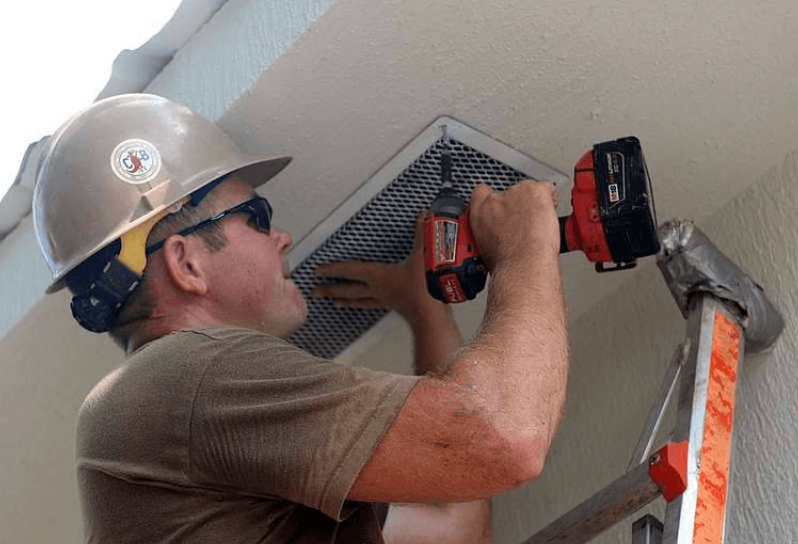
Effective attic ventilation maintain a healthy home environment, reduces energy costs, and prolongs the lifespan of roofing materials. Soffit vents play a key role in this system by allowing fresh air to enter the attic, balancing the temperature and moisture levels inside.
Understanding Soffit and Soffit Vents
A soffit is the underside of any construction element, but when referencing homes specifically, it usually means the material forming a ceiling from the top of an exterior house wall to the outer edge of the roof. Soffit vents are integrated into this space to facilitate airflow into the attic, working in tandem with ridge vents or other exhaust systems to ensure proper air circulation.
This intake of air helps to push out the hot, moist air that naturally rises and exits through higher ventilation points, such as ridge or gable vents. By maintaining this steady airflow, soffit vents help regulate the temperature in the attic, prevent moisture buildup that can lead to mold and mildew, and ultimately protect the integrity of your roof and reduce energy costs. They are critical in preventing issues like mold growth and wood rot by maintaining a dry and cool roof and attic structure.

Calculating Your Needs: A Simple Guide
To determine how many soffit vents you need, start by calculating the total square footage of your attic. This is generally the same as the footprint of your home. Building codes typically require 1 square foot of vent area for every 150 square feet of attic space. Half should be intake venting, like soffit vents, and the other half should be exhaust. For instance, if your attic is 1,500 square feet, you’d need 10 square feet of venting, with 5 of those as soffit vent area.
Ideal Ventilation Ratios
The ratio of vented soffit area to attic floor area is important for efficiency purposes. Ideally, the ventilation should be split evenly between intake and exhaust, promoting balanced airflow throughout the attic. This ratio helps in minimizing the potential for moisture buildup and heat accumulation, which are detrimental to roof health and energy efficiency. Following this ratio ensures that your attic is adequately ventilated, maintaining a cool and dry environment conducive to the structural integrity of your home.
Material Choices for Soffit Vents
Choosing the right material for your soffit vents is critical to their effectiveness and durability. Common materials include:
- Aluminum: Lightweight and resistant to rust, aluminum soffit vents are popular for their durability and low maintenance. They can be painted to match your home’s exterior.
- Vinyl: Vinyl vents are cost-effective and resistant to corrosion and rot, making them suitable for humid climates. However, they may become brittle in extreme cold.
- PVC: Similar to vinyl, PVC soffit vents offer excellent moisture resistance and are ideal for coastal areas due to their salt resistance. They also maintain color well, resisting UV degradation.
- Steel: For maximum durability, especially in regions with severe weather, steel soffit vents are an excellent choice. They can handle heavy snow loads and high winds but are prone to rust if not properly treated.
Each material offers unique benefits and potential drawbacks. Consider your climate, the aesthetics of your home, and longevity when choosing the material for your soffit vents.
Complying with Local Building Codes
Before installing soffit vents, it’s crucial to understand and comply with local building codes. These regulations can vary significantly by location and are designed to ensure safe, effective installation of building components. Here’s how you can navigate these regulations:
- Check with Local Authorities: Visit your local building department or their website to get the specific codes and requirements for soffit vent installation in your area.
- Permits: Some regions may require a permit for modifications to your home’s exterior, including the addition of soffit vents.
- Hiring Professionals: Consider hiring a licensed contractor who is familiar with local codes and installation practices. This can ensure compliance and avoid potential issues with inspections.
- Inspection Requirements: After installation, an inspection might be necessary to ensure the work meets local standards and codes.
Adhering to local building codes not only ensures safety but can also prevent legal issues and potential fines. It’s worth investing time to understand these requirements thoroughly before starting your project.
Conclusion
Proper soffit ventilation is just one of the many keys to protecting the structural integrity and energy efficiency of your home. Taking the time to understand soffit venting can help you maintain a healthy attic environment. This proactive approach not only extends the life of your roof but also contributes to a more comfortable and cost-effective living space.





